| When Two Yarns Meet: The Art of Stranding |
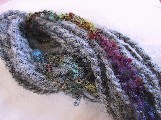 | |
|
If you're a fan of quick-knitting projects or enjoy unusual textures and color combinations, why not consider stranding your next project? I don't mean dumping it out the car window or leaving it on a deserted park bench. Rather, I'm talking about the kind of stranding where you knit with multiple strands rather than just one. It's a marvelous but often misunderstood technique that offers almost limitless possibilities. Rules of the Game There are a few things to know before you begin experimenting. First and foremost, the effect you want to achieve impacts your choice of yarns. The three main variables in stranding are:
If you simply want to bulk up your project, either for added thickness or to make it knit up faster, the world is your oyster. Your easiest option is simply to double up on the same yarn in the same color. You may also want to try a subtle variation in colors to add depth to your work. Even a slightly different shade of the color can produce lovely results. |
||
| Adding Texture |
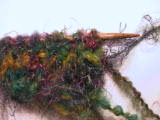
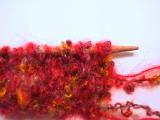 | |
| Stranding is also an easy way to add texture to an otherwise flat garment. Two of the most common texture-producing additions are boucle and slubby yarns. The above images show a combination of slubby and furry yarn (left image) and a pairing of mohair and boucle (right image).
It's important to keep in mind, however, that not all yarns will strand harmoniously. Those with a tight spin and high surface definition tend to hog the spotlight if you try and blend them with a quieter yarn. The result is an awkward "did you mean to do that?" effect. A way to get around this is to match your colors as closely as possible. The similar colors help subdue the yarn differences and give the fabric a three-dimensional effect at the same time. Keep in mind that up close it may still look slightly odd. | ||
| Creating Color |
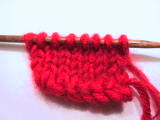
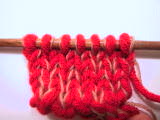 | |
| Obviously it's easiest to strand two of the exact same yarn. This gives you a faster-knitting, bulky project without adding any complexity. (The above-left image shows one such combination.)
If you want to have more fun, here are some other color options and the effects they generally produce. Keep in mind that some colors simply won't mix. (The above-right image is an example.)
| ||
| What are the Best Yarns for Stranding? |
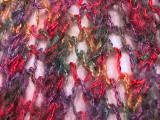 | |
| How well will two yarns combine? Here's a simple test to find out. Take one strand of each, twist them together, and then wrap the combined strand several times around your finger. How well do the two blend? Does one strand jump out at you more than the other?
The "Blur" Factor Since you're trying to achieve a harmonious blend with your strands, often the best blends for stranding are those yarns with a softer, more blurry look to them. An example of this is Classic Elite's Pandemonium, which combines a strand of brushed mohair (La Gran) and a strand of mohair boucle (Commotion). Chenille Chenille yarns also blend well, especially with brushed mohair. Classic Elite's three-strand Wildflowers yarn is made up of a strand of mohair, rayon chenille, and textured cotton. The only problem with chenille when stranded with other yarns is that it may have a tendency to "pop" out of the fabric. Be prepared to tug it back into place periodically, either by hand or with the help of a crochet hook. Berroco Chinchilla is a lovely chenille for stranding with Glace (also from Berroco) because it has a furry texture with a good amount of heft and slink. Other successful combinations I've seen include brushed mohair and rayon (Fiesta Yarns' La Boheme, shown in the above image, is an exquisite example of this). | ||
| Down in Front! |
||
| When you're stranding two types of yarns, rarely will they blend perfectly. Instead, one strand normally dominates the pattern while the other moves to the background and anchors the work.
This is especially true when you're working with brushed mohair. It will naturally subdue whatever else you're using with it. This can be good if you're working with bright-colored yarns (especially silk or rayon), because the mohair will subdue the intensity of color. It's not a good idea to pair mohair with a yarn whose texture and color you want to see clearly, however. I tried blending mohair with an exquisite yarn that combined angora, cashmere, and silk, and all subtlety was lost. I ended up using a strand of Henry's Attic alpaca instead. | ||
| Getting Good at Gauge |
||
| Be sure to give your stranded work ample breathing room. You may have to go up several needle sizes before you reach a comfortable texture.
Speaking as someone who didn't give the strands enough room and ended up with a bulletproof sweater, I can assure you that the extra time to get your gauge right will pay off in the end. If you're stranding two bulky yarns, prepare to use surprisingly big needles. | ||
| A Few Words on Fulling |
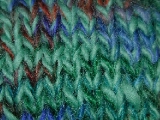 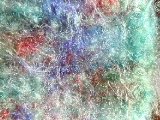 | |
| Stranding is a popular technique for fulling. Here you are more free to experiment with tighter-spun yarns because the fulling process will cause them to relax and combine with their companions. (The images above show a combination of Brown Sheep Lamb's Pride Worsted and Hand Paint Originals before and after fulling.)
Because spun fibers require free movement before they can full, be sure to leave even more open space in your work than you would with a normal-sized project. Most fulling patterns will specify the exact gauge you need. | ||
|
Add your comments!
Reader comments "I'm currently working on a vest using one strand of a variegated acrylic and one strand of thin black yarn from a cone. I started with just the variegated yarn, but the fabric just didn't pop. I added the black, and BOOM - the colors just spring from the fabric now. I can't wait to finish it!" Lissa, 9/3/2001 "I liked your article on stranding. I have been doing it for years! It is really a matter of making sure you end up with the correct "ply" to match your chosen pattern. As I live in the UK our yarns are slightly different in weight but the procedure is the same. I have made some very nice 'mixtures' using coned machine yarns as well. They are usually fine yarns, often cheaper in a sale, and can give a very wide range of colourations without 'breaking the bank'! I know I live a long way away from most of your readers but I still enjoy your articles, after all Knitting is International and speaks the same language to its followers." Anwen, 9/2/2001 "I knitted and fulled a stuffed chicken using the double strand technique. By combining orange and black, I ended up with a chicken that looks like a barred rock. Very realistic." safarikari, 9/1/2001 "In reference to the question about the gauge of doubled yarn: I've found that doubling a yarn moves it up one "category", i.e. double fingering(7/inch) gives sport gauge (5-6/inch), double sport gives worsted gauge(5/inch), doubling worsted gives bulky (3-4/inch), doubling bulky means get out the broomsticks!" doughty, 9/1/2001 "Thanks for the great article! I've got some LaGran mohair in purple and yellow, plus some eyelash; think I'll strand with black to make a great shawl! Never thought about doing this before; nice article!" jcfdoldmedic, 9/1/2001 "I enjoyed your article on stranding. If one wishes to use a tool from a slightly different (yet related) craft to combine colors and textures, taking two commercial yarns, and plying them together with a spinning wheel is a quick and effective way to produce a new yarn. I don't like getting tangled up in strands, so a multi-ply yarn works better for me. It is also easy to determine yarn wpi that way. Thanks for a great newsletter." Adina, 9/1/2001 "I have completed 3 stranded projects, all using 2 or more of the same yarn. The last sweater I knitted combined 3 strands of Lamb's Pride in three different shades of purple. It's a beautiful sweater and I found it to be an economical alternative to a more expensive, bulky yarn." allicobb, 8/31/2001 "Thanks for the great article on stranding. I am always trying to combine my stash colours and this article gave me a fresh perspective and some new ideas on how to do this." Maryanne, 8/31/2001 "Great article on stranding! But I'm left with a question that may be hard to answer: how do you determine the gauge. For example, if the pattern suggests superbulky yarn, and I want to combine two yarns, how do I know what weights to combine to achieve the approximate gauge?" mritan, 8/31/2001 "This is my second comment to you, and it's on the same topic- bulky yarns. What's the deal? Not all of us enjoy thick, dare I say it, unweildly sweaters,etc. Many (I hope) prefer to knit DK or smaller, but I'd be satisfied with a review of even a worsted yarn. I know bulky is the flavor of the month, but show some interest in those of us who have been knitting for more tan a month and may want to put a bit more effort into it." pbouvier, 8/31/2001 This article was part of our August "back-to-school bulkies" series, in which we focused exclusively on bulky, quick-knitting yarns. Many experienced knitters also enjoy taking breaks to do fast-knitting bulky projects, but I understand that we all like variety in our yarn types. We'll continue to cover a full variety of yarns, thick and thin. Thanks for writing! -Clara "Stranding two, or more, yarns is a lot of fun! It's not that hard, just give it a try. Use simple stitches, fancy stitches are usually lost. Also, look at both the knit and purl side. Yarns will act differently depending on the stitch, some will 'hide' on the purl side, which you might want to use as the 'right' side. Just play around with swatches and see what you get. You may never go back to plain yarns again!" klao, 8/31/2001 "I have a fear of stranding -- I always worry about laundering and having something die. Any suggestions?" Bach, 8/31/2001 "Stranding is great but another problem I found is stretch. I'm allergic to wool and most of the large needle patterns call for it. I combined two acrylic strands, got the right gauge, but the sweater is too stretchy to wear. Keep that in mind too!" San5345, 8/31/2001 |
||
Featured how to
The Fret-Free Fisherman's Knot
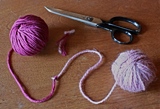
We've all been trained to avoid knots in our knitting. But if you must, here's one that'll hold your yarn tight.
![]() read more
read more
Favorites
Copyright © 2000-2016 Clara H. Parkes
All rights reserved. Permission to reproduce is required.
All rights reserved. Permission to reproduce is required.



